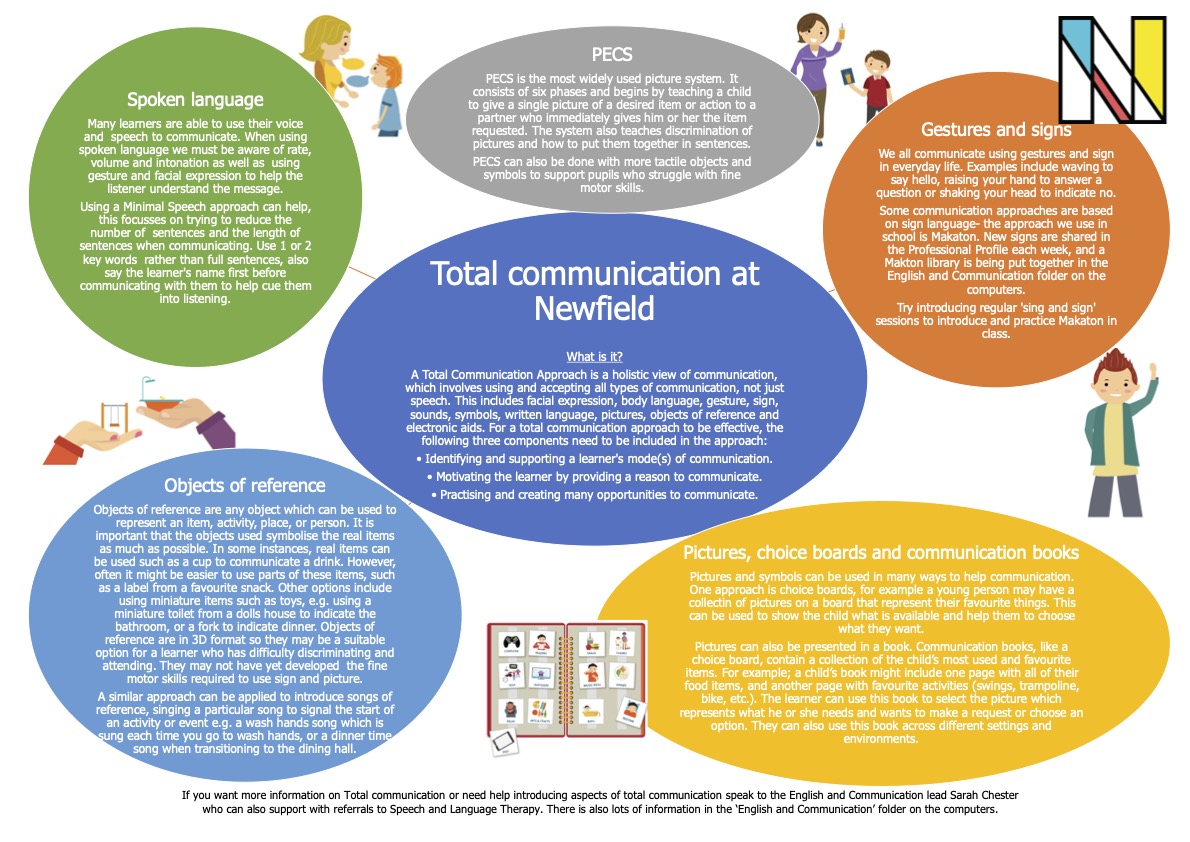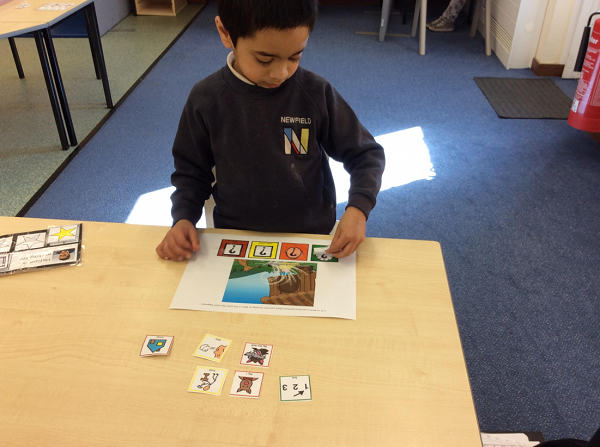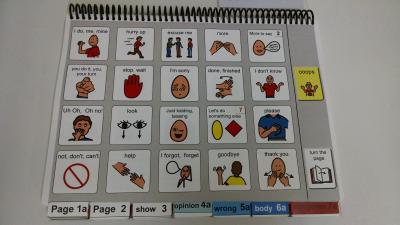Communication
Communication is a vital part of everyday living. At the School for Autism @ Newfield learners have a wide variety of communication styles and abilities and we employ at range of strategies to support the development of meaningful functional and social communication. Find out more about them below:

Download out Total Communication Flyer
Clcik herePicture Exchange Communication System (PECS)
The Picture Exchange Communication System aims to provide an alternative method of communication and to develop spontaneous social communication. The idea is to make communication functional and understandable. For some children, it can also help to promote speech development by using the pictures or symbols to model speech. PECS uses pictures or symbols as the means of communication. Pupils learn to give a ‘communication partner’ a picture or symbol to request an item they want or to respond to questions.
PECS consists of six phases and begins by teaching pupils to give a single picture or symbol of a motivating item or action to a “communicative partner” who immediately responds to the exchange as a request and gives the pupil the item or action they have requested. The system goes on to teach discrimination of pictures and how to put them together in sentences. In the more advanced phases, pupils will expand their vocabulary by using a wider range of symbols and answer questions or make comments. When teaching PECS non-verbal prompts are used as these can be easily removed which help promote pupils to communicate independently and spontaneously. PECS is used at all times of the day as it is the child’s voice, so their PECS book travels with them at all times. You can find out more information about PECS here.
PECS School for Autism @Newfield
At Newfield our teachers are all given PECS training within two years of joining our team, which means we have a highly qualified staff team who can support our pupils to learn how to use PECS to communicate effectively. This is supported by Speech and Language Therapist working alongside class teams to promote the use of PECS. Pupils use PECS throughout the day to make requests such as asking for snacks, dinner and to request toys during leisure times. They also use PECS during lessons to request favoured props from a story or request items needed to complete a task like paints and glue. Pupils participate in lessons by commenting on lesson activities such as talking about what they can see, hear and smell. Pupils are also encouraged to use PECS to ask for help or to go to the toilet.

Makaton
Makaton is a language programme using signs and symbols to help people to communicate. It is designed to support spoken language and the signs and symbols are used with speech, in spoken word order. Makaton uses speech with signs (gestures/ similar to sign lanuage) and symbols (pictures) to help people communicate. We also use facial expression, eye contact and body language to give as much information as possible. Children and adults can use Makaton to let others know what they want, make choices, share information and understand more. This helps build and develop important communication and language skills. Makaton has been used by Mr Tumble on Cbeebies Something Special which has helped promote Makaton with younger children as they have learnt the signs and symbols.
You can find out more information about Makaton here.

Makaton - School for Autism @Newfield
At Newfield we have a qualified Makaton Trainer (Laura Holmes) who is available to support staff and pupils to learn signs and give advice to parents. We regularly run training courses at school for staff and parents. Our school choir also use Makaton to sing and sign.
Intensive Interaction
Intensive Interaction is an approach designed to help people at the early levels of development, people who have severe, profound or complex learning difficulties and people who have autism. It works on early interaction abilities such as enjoying being with other people. It encourages pupils to relate, interact, know, understand and practice communication routines. It develops the ‘fundamentals of Communication’ such as using and understanding eye contact, facial expressions, vocalisations leading to speech, taking turns in exchanges of conversations and the structure of conversations. Intensive Interaction teaches and develops interaction and communication by doing and taking part in child led interaction and communication using strategies such as copying and repeating actions and/or vocalisations, giving time for pupils to respond and modelling and expanding interactions.
You can find out more information here.
Intensive Interaction - School for Autism @Newfield
At Newfield we encourage opportunities for intensive interaction both in specific planned sessions and we also use it throughout the day during in a more naturalistic way. Speech and Language Therapist work alongside teachers to plan intensive interaction sessions where appropriate.
Colourful Semantics
Colourful semantics helps pupils to understand the meaning of words by breaking them down into categories that use colours to help organise the words and help pupils make structures sentences. It can also help with expanding vocabulary, improving sentence length, improving the use of nouns, verbs, adjectives and adverbs. Colourful semantics uses symbols to help sort and order words but it can also be used to help develop speaking, listening and writing skills. Pupils can use colourful semantic to sort words in categories, respond to questions and make sentences. Activities can be linked to stories in English or be used to encourage discussions and conversation around an activity.

At Newfield we use the following colour scheme for each group of words:
- Who – Orange
- What Doing (verbs) -Yellow
- Where – Red
- Objects (nouns) – Brown
- When - Green
- Descriptors and emotions - Purple
PODD
A PODD stands for:
- Pragmatic – the ways that we use language socially and with purpose
- Organisation – words and symbols arranged in a systematic way
- Dynamic Display – changing pages for a wide vocabulary and range of statements
PODD is a way of organising whole-word and symbol vocabulary in a communication book or speech generating device to support expression and understanding of language for people with complex communication needs,
The aim of a PODD is to provide vocabulary for use in multiple environments, with a range of messages, across a range of topics. It is designed to be a tool in someone’s ‘toolbox of communication methods’ that is useful all the time. Selection of words and symbols in the PODD can be made by pointing, looking or other combinations of methods.
Communication methods we use day-to-day include speech, gestures, pointing, facial expressions and writing, and we tend to choose whichever method is most effective for each situation. In the same way, a person with complex communication needs may use a number of different methods to communicate including a PODD, depending on what is most efficient method for them at the time.
There’s many different types of PODDs, so the one used will depend on the communication needs of the individual. Everyone has different communication preferences and abilities. This is why PODDs can have different formats, depending on the individual physical, sensory and communication needs of the user.
PODD books offer an opportunity for pupils to communicate all of the time about a wide range of topics as it is organised it categories making it easy and simple to communicate using a larger vocabulary of words. PODD can also be an effective learning tool to help pupils understanding of spoken language as communication partners can also use the book to point to the symbols as they talk to the pupil.
